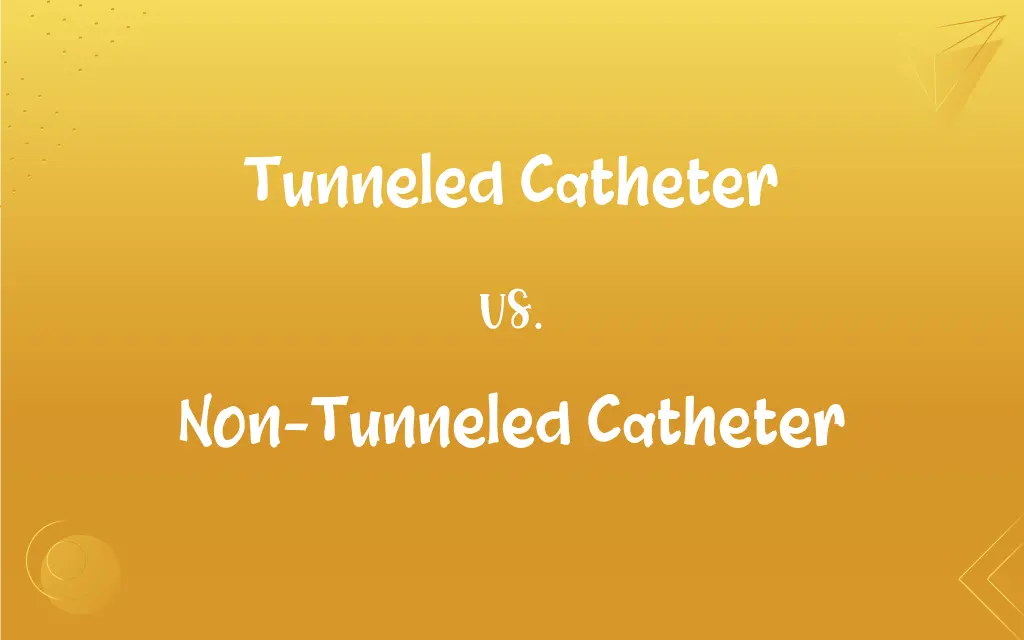Tunneled Catheter vs. Non-Tunneled Catheter: What's the Difference?
Edited by Aimie Carlson || By Janet White || Published on February 27, 2024
Tunneled Catheter is a catheter inserted into a vein with a portion tunneled under the skin to reduce infection risk. Non-Tunneled Catheter is a catheter directly inserted into a vein without subcutaneous tunneling, used for short-term access.

Key Differences
A Tunneled Catheter is distinct in its design, featuring a portion that is tunneled under the skin, thereby reducing the risk of infection. This contrasts with a Non-Tunneled Catheter, which is directly inserted into a vein without this subcutaneous tunneling, often used for immediate or short-term vascular access.
The insertion process of a Tunneled Catheter is more complex and typically done in a surgical setting, providing long-term access. On the other hand, Non-Tunneled Catheters are simpler to insert, often in emergency or acute care settings, reflecting their utility for short-term use.
Maintenance and care differ between the two: Tunneled Catheters often require less frequent site care due to their design minimizing infection risks. Conversely, Non-Tunneled Catheters, being more exposed, need more rigorous and regular site care to prevent infections.
In terms of applications, Tunneled Catheters are typically used for long-term treatments like chemotherapy, requiring stable and secure venous access. Non-Tunneled Catheters are more common in acute hospital settings for quick administration of medications or fluids.
The removal process varies: removing a Tunneled Catheter often requires a small procedure due to its under-skin tunneling, whereas Non-Tunneled Catheters can be removed simply and swiftly, aligning with their short-term application.
ADVERTISEMENT
Comparison Chart
Insertion Method
Surgically tunneled under the skin
Directly inserted into a vein
Duration of Use
Designed for long-term use
Suitable for short-term use
Infection Risk
Lower due to subcutaneous tunneling
Higher due to direct exposure
Maintenance
Requires less frequent care
Needs regular care to prevent infection
Application in Treatment
Common in long-term treatments like chemotherapy
Used primarily in acute or emergency care settings
ADVERTISEMENT
Tunneled Catheter and Non-Tunneled Catheter Definitions
Tunneled Catheter
A catheter involving a surgical procedure for placement.
Surgical placement of the tunneled catheter was scheduled for today.
Non-Tunneled Catheter
A catheter designed for short-term vascular access, often used in emergencies.
In the ER, a non-tunneled catheter was quickly placed for the treatment.
Tunneled Catheter
A catheter designed for long-term use with a part tunneled beneath the skin.
The patient received a tunneled catheter for ongoing chemotherapy.
Non-Tunneled Catheter
A catheter suitable for acute care and short-term treatments.
For his brief hospital stay, a non-tunneled catheter was sufficient.
Tunneled Catheter
Used for stable, long-term vascular access, particularly in chronic conditions.
Tunneled catheters are ideal for patients requiring long-term IV medications.
Non-Tunneled Catheter
A catheter inserted directly into a vein for immediate use.
They used a non-tunneled catheter for the urgent IV fluid administration.
Tunneled Catheter
A catheter preferred for treatments where frequent access to a vein is needed.
For his dialysis, a tunneled catheter was chosen for easier vein access.
Non-Tunneled Catheter
A catheter that can be inserted without the need for a surgical procedure.
The nurse inserted the non-tunneled catheter without needing surgery.
Tunneled Catheter
A catheter that reduces infection risk through its subcutaneous tunnel.
Her tunneled catheter's design minimizes the risk of infection.
Non-Tunneled Catheter
A catheter with a higher risk of infection due to its direct insertion method.
Due to its nature, the non-tunneled catheter required vigilant site care.
FAQs
How is a Non-Tunneled Catheter inserted?
It is directly placed into a vein, usually in an acute care setting.
How does a Tunneled Catheter reduce infection risk?
Its under-skin tunneling shields it from direct exposure to pathogens.
What is the primary use of a Tunneled Catheter?
For long-term treatments like chemotherapy or chronic IV therapy.
Why is a Non-Tunneled Catheter more prone to infections?
Its direct and external placement makes it more exposed to infection risks.
What is a Non-Tunneled Catheter?
A catheter directly inserted into a vein, used for short-term vascular access.
What is the primary use of a Non-Tunneled Catheter?
For short-term or emergency treatments requiring immediate vein access.
How is a Tunneled Catheter inserted?
Through a minor surgical procedure, part of it is tunneled beneath the skin.
Is a Non-Tunneled Catheter suitable for long-term use?
No, it's primarily intended for short-term or immediate use.
Is surgical removal required for a Tunneled Catheter?
Yes, a small procedure is often needed due to its under-skin tunneling.
What is a Tunneled Catheter?
A long-term use catheter with a portion tunneled under the skin to reduce infection risks.
Can a Tunneled Catheter be used for emergency treatments?
It's not typically used in emergencies due to its complex insertion process.
Do Tunneled Catheters require a specialized team for insertion?
Yes, typically a surgical team is required for their placement.
Can Non-Tunneled Catheters be inserted by general nursing staff?
Yes, they can often be inserted by trained nurses or medical staff.
Are Tunneled Catheters used in dialysis?
Yes, they're often used in dialysis for stable, long-term vein access.
How often does a Non-Tunneled Catheter need site care?
Regularly, to prevent infections due to its direct vein exposure.
Can a Non-Tunneled Catheter be easily removed?
Yes, it can be quickly and easily removed as it's not tunneled.
How often does a Tunneled Catheter need site care?
Less frequently, due to its design minimizing infection risks.
Are Non-Tunneled Catheters used for fluid resuscitation?
Yes, they're commonly used for quick fluid administration in acute care.
What is the durability of a Tunneled Catheter?
They're designed to be durable for extended periods of use.
Is a Non-Tunneled Catheter durable for long-term use?
No, they're not designed for durability beyond short-term treatment.
About Author
Written by
Janet WhiteJanet White has been an esteemed writer and blogger for Difference Wiki. Holding a Master's degree in Science and Medical Journalism from the prestigious Boston University, she has consistently demonstrated her expertise and passion for her field. When she's not immersed in her work, Janet relishes her time exercising, delving into a good book, and cherishing moments with friends and family.
Edited by
Aimie CarlsonAimie Carlson, holding a master's degree in English literature, is a fervent English language enthusiast. She lends her writing talents to Difference Wiki, a prominent website that specializes in comparisons, offering readers insightful analyses that both captivate and inform.







































































